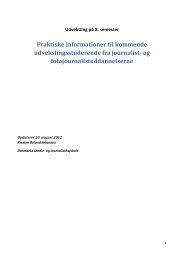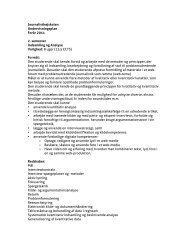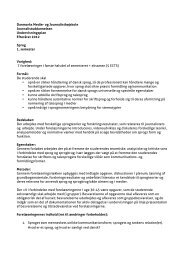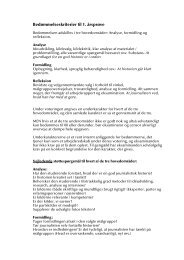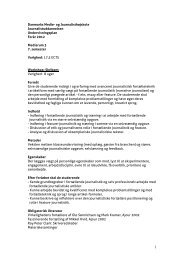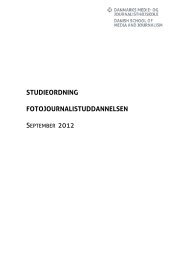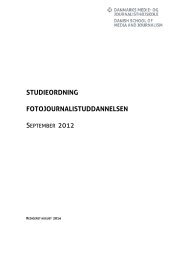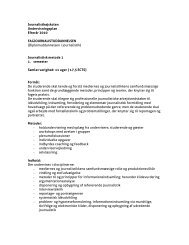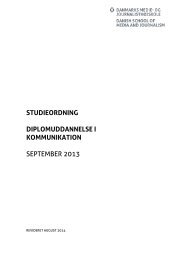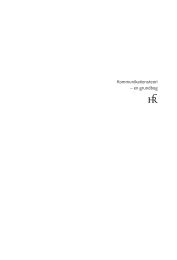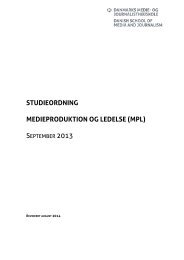Understanding text and picture content as a unity
Understanding text and picture content as a unity
Understanding text and picture content as a unity
Create successful ePaper yourself
Turn your PDF publications into a flip-book with our unique Google optimized e-Paper software.
<strong>Underst<strong>and</strong>ing</strong> <strong>text</strong> <strong>and</strong> <strong>picture</strong><br />
<strong>content</strong> <strong>as</strong> a <strong>unity</strong><br />
By Niels Heie<br />
Graphic Designer, researcher, The Graphic Arts Institute of Denmark<br />
In graphic communication messages are often understood in another way by receivers, than intended by senders.<br />
Inspired by the idea, that rhetorics is a study of misunderst<strong>and</strong>ing (Richards, 1939), this paper present<br />
an experiment in which the combination of <strong>picture</strong>s <strong>and</strong> <strong>text</strong>s <strong>as</strong> used in modern graphic products is examined.<br />
24 adult informants should chooce between sentences related to <strong>picture</strong>s the way the two are related, for<br />
instance <strong>as</strong> photos <strong>and</strong> captions in newspapers. 12 <strong>picture</strong>s, each one with three sentences to choose among,<br />
were presented in two different layouts: L1 with one <strong>picture</strong>, L2 with three copies of the same <strong>picture</strong>.<br />
Informants were eyetracked while deciding which combination <strong>content</strong>wise could be considered most objective,<br />
subjective, non-sensical.<br />
Time me<strong>as</strong>ures showed that informants used app. 25% more time on the subjective than on the objective t<strong>as</strong>k.<br />
A difference in the subjective t<strong>as</strong>k w<strong>as</strong> found between the two layouts: in spite of the average time used<br />
w<strong>as</strong> the same, in L2 layouts informants used more time at <strong>picture</strong>s than at <strong>text</strong>s, opposite the result when<br />
choosing the subjective combination in L1 where most time w<strong>as</strong> used on <strong>text</strong>.<br />
App. 92% of choices for the objective <strong>content</strong> relation were <strong>as</strong> foreseen, app. 77% for the subjective.<br />
The experiment showed that interdependedness should be considered when making visual communication<br />
<strong>and</strong> that both layout <strong>and</strong> complexity of <strong>content</strong> influences the time used by the reader. For further research<br />
it is suggested that <strong>picture</strong>s <strong>and</strong> <strong>text</strong>s in graphic communication products are seen <strong>as</strong> elements in the<br />
argumentative structure introduced by Stephen Toulmin. 1<br />
Two codes<br />
Multimodality is at the heart of modern graphic communication products. People working<br />
with graphic communication, being author or designer, photographer or advertiser works<br />
with multimodality, more or less consciously.<br />
In this article multimodality st<strong>and</strong>s for the use of static <strong>picture</strong>s <strong>and</strong> <strong>text</strong>s presented in<br />
static layouts. The <strong>content</strong>s of the elements are considered interrelated <strong>as</strong> a way to present<br />
a message.<br />
Multimodality is used in wide variety in graphic products, from simple compositions<br />
<strong>as</strong> in identitycards containing a photographic portrait with a name under it, over more<br />
complex compositions of <strong>picture</strong>, title, authorname <strong>and</strong> tagline on a bookcover, to broadsheet<br />
newspaper spreads contaning several articles with several <strong>picture</strong>s combined by layout<br />
with headlines, captions, copy<strong>text</strong>s.<br />
Multimodality is used whether graphic products are intended for efferent reading <strong>as</strong><br />
in an IKEA do-it-yourself manual or for aestetic reading <strong>as</strong> in a lifestyle magazine<br />
(Rosenblatt, 1978).<br />
Pictures <strong>and</strong> <strong>text</strong>s are signs. In the semiotic terminology of Charles S. Peirce (Lizla,<br />
2001) <strong>text</strong>s are symbolic signs, <strong>picture</strong>s are iconic.<br />
The combination of <strong>picture</strong>s <strong>and</strong> <strong>text</strong> <strong>as</strong> a means of visual expression is in line with<br />
Paivios concept of dual coding, dividing in cognitive processes in two systems. The imagery<br />
system is underst<strong>and</strong>ing scenes <strong>and</strong> situations <strong>and</strong> generates images. The verbal system is<br />
underst<strong>and</strong>ing language <strong>and</strong> generates speech (Paivio, 1978).<br />
Elements in visible messages<br />
Communication <strong>as</strong>sumes that two parties, sender <strong>and</strong> receiver, agrees on the meaning of<br />
the signsystem used. To be communicated a message h<strong>as</strong> to be encoded in a way that the<br />
sender imagines the receiver is able to decode.
Graphic communication using multimodality is dependent on the readers ability to read<br />
written language, but also his ability to read <strong>picture</strong>s, <strong>as</strong> well <strong>as</strong> to read the composition<br />
of the two shaped by the layout.<br />
In spite of this, not much research have been done in the field (Rayner 2001, Holsanova<br />
2005), all though, for instance, lots of children have learned to read <strong>text</strong> looking at words<br />
placed in a multimodal compositions: A word is related to a <strong>picture</strong> to make the child<br />
underst<strong>and</strong>, that the referent of the word is presented in a <strong>picture</strong> of the referent.<br />
Children learn that bird is the word for a <strong>picture</strong> of a bird – which makes Rene Magrittes<br />
painting ”The Use of Words” (1928), of an iconic pipe above a symbolic line saying ”This is<br />
not a pipe” a b<strong>as</strong>ic <strong>picture</strong> of a b<strong>as</strong>ic condition.<br />
Text is written words that the reader underst<strong>and</strong>s <strong>as</strong> <strong>picture</strong>s of spoken words. Text<br />
h<strong>as</strong> a message. Where <strong>as</strong> <strong>picture</strong>s – in this study photographic <strong>picture</strong>s – can be considered<br />
<strong>as</strong> a medium without the linguistic quality of having a message (Barthes, 1977, Elbæk,<br />
1987). Multimodal graphic communication products then, combine language <strong>and</strong> nonlanguage<br />
elements in compositions <strong>as</strong> if they could be understood <strong>as</strong> unities. But can they?<br />
Reading both <strong>picture</strong> <strong>and</strong> words<br />
Elbro (Elbro, 2001) in a model of reading ability defines it, <strong>as</strong> the ability to decode letters<br />
<strong>and</strong> words related to the ability to underst<strong>and</strong> the meaning of language.<br />
To fit the multimodal communicating products then, the concept of reading must be<br />
exp<strong>and</strong>ed because a reader h<strong>as</strong> to decode both <strong>text</strong>, <strong>picture</strong>s <strong>and</strong> the layout containing<br />
them <strong>and</strong>, through the cohesiveness of the elements, underst<strong>and</strong> the meaning of elements<br />
<strong>and</strong> layout <strong>as</strong> a coherent <strong>unity</strong>: i.e. why this <strong>text</strong> goes with this <strong>picture</strong> within this format<br />
in this way.<br />
The exp<strong>and</strong>ed model thus looks like this: reading ability is the decoding of visual elements<br />
<strong>and</strong> the underst<strong>and</strong>ing of there mutual relation <strong>as</strong> a whole. The model suggests<br />
that a dual coded message should be read in a dual coded way <strong>and</strong> result in a coherent<br />
underst<strong>and</strong>ing of the meaning of the presented modalities.<br />
If a message is understood in a certain way when presented in <strong>text</strong> alone, what happens<br />
to the underst<strong>and</strong>ing of the message if it is presented in the same <strong>text</strong> but added a<br />
sense making <strong>picture</strong>? Taking the multimodal version <strong>as</strong> a coherent <strong>unity</strong>, the difference<br />
in underst<strong>and</strong>ing between the unimodal <strong>and</strong> the multimodal version ought to be a difference<br />
in the <strong>content</strong> of the readers inferring.<br />
Background for better routines<br />
In the production of graphic communication experience b<strong>as</strong>ed habits dictate daily routines<br />
on how to combine <strong>picture</strong>s <strong>and</strong> words. To get more explicit knowledge in the field,<br />
i.e. get a better underst<strong>and</strong>ing of <strong>picture</strong>/<strong>text</strong> cohesion <strong>and</strong> eye movements, we made a<br />
study using eyetracking equipment to test whether combination of <strong>picture</strong>s <strong>and</strong> words in<br />
this daily-b<strong>as</strong>is way, were understood by informants <strong>as</strong> intended.<br />
Our experiment w<strong>as</strong> in line with two specific studies, one about the reading of illustrated<br />
<strong>text</strong>books, one about the underst<strong>and</strong>ing of ads composed of <strong>picture</strong>s <strong>and</strong> <strong>text</strong>s having<br />
either implicit or explicit <strong>content</strong>.<br />
In the illustrated <strong>text</strong>book study (Hannus, 1999) six spreads from new biology <strong>text</strong>books<br />
were presented to 108 fourth grade schoolchildren scored to be on different levels of <strong>text</strong><br />
reading ability. The experiment showed, that students in general mostly learned from<br />
<strong>text</strong>, that students of high <strong>text</strong> reading ability incre<strong>as</strong>ed their underst<strong>and</strong>ing of the <strong>content</strong><br />
by use of the illustrations <strong>and</strong> that students of low <strong>text</strong> reading ability were confused<br />
by the illustrations. Eyetracking showed that able readers could change from <strong>text</strong> reading<br />
to <strong>picture</strong> reading <strong>and</strong> back again without confusion. Less able readers had problems<br />
changing from one modality to the other.<br />
In the ad study (Radach et. al. 2003) 32 grown ups were presented to several ads composed<br />
of <strong>picture</strong>s <strong>and</strong> <strong>text</strong>s. The <strong>content</strong>s of the ads were defined <strong>as</strong> explicit or implicit: in<br />
niels heie 23.07.07 / underst<strong>and</strong>ing <strong>text</strong> <strong>and</strong> <strong>picture</strong> <strong>content</strong> <strong>as</strong> a <strong>unity</strong> 2
explicit ads <strong>content</strong> of <strong>text</strong> <strong>and</strong> illustration w<strong>as</strong> in a direct semantical relationship <strong>and</strong> the<br />
message w<strong>as</strong> presented in a straightforward way. In implicit ads the <strong>content</strong> w<strong>as</strong> in a<br />
more complex semantical relationship <strong>and</strong> the message w<strong>as</strong> presented indirectly. The<br />
result w<strong>as</strong> that explicit ads were read f<strong>as</strong>ter than implicit ones <strong>and</strong> that informants<br />
expressed a bigger ”liking” for implicit ads than for explicit ones. The likeability part of<br />
the result is interesting. Likeability in ads correlates to the sale of advertised goods<br />
(Radach et. al. 2003).<br />
In a not published small pretest-experiment we tested if illustration had any influence<br />
on solving a t<strong>as</strong>k, where three 4-person groups of grown ups of expected equal reading<br />
abilities (attending same level of education) individually should decide, which word six<br />
letters non-obviuos presented were forming. The letters were presented on a computerscreen<br />
this way:<br />
a<br />
v u<br />
a l t<br />
The word to find w<strong>as</strong> valuta, i.e danish for currency. To get an impression of the t<strong>as</strong>k<br />
read the word currency in this layout:<br />
y<br />
c r n<br />
u r e c<br />
One group saw letters alone, another group saw letters in a layout with a detached photo<br />
of coins, a third group saw letters with a detached photo of keys. (Detachment of a photo<br />
removes the background <strong>and</strong> makes the appereance of the figure letterlike). While looking<br />
informants eye movements were registrered.<br />
Result, average time used to find the answer:<br />
• coin-photo-group 09 sec<br />
• no-photo-group 42 sec<br />
• key-photo-group 52 sec<br />
The conclusion of these studies <strong>and</strong> the pretest w<strong>as</strong>:<br />
• Readers overall underst<strong>and</strong>ing is influenced by the <strong>picture</strong>-<strong>text</strong> <strong>content</strong> relationship<br />
• The <strong>picture</strong>-<strong>text</strong> <strong>content</strong> relationsship can be described <strong>as</strong> explicit or implicit<br />
• Time used seems to vary according to difficulty of t<strong>as</strong>k<br />
The not so simple experiment<br />
Overall we wanted to test how informants would choose among a series of <strong>picture</strong> <strong>and</strong><br />
<strong>text</strong> combinations presented four times <strong>and</strong> if choises were <strong>as</strong> researchers expected.<br />
Informants should choose <strong>as</strong> if they were like an editor choosing adequat <strong>picture</strong>s <strong>and</strong><br />
captions.<br />
Three choises should be made within the frame of the explicit/implicit concept. To get<br />
a better underst<strong>and</strong>ing of the limit of the explicit/implicit categories, we invented a category,<br />
call it ”nonplicit”, i.e. if the <strong>picture</strong>/<strong>text</strong>s relation w<strong>as</strong> experienced <strong>as</strong> absurd.<br />
Before the test, informants saw the two layout versions of the stimulus <strong>picture</strong>s, were<br />
informed of the t<strong>as</strong>k <strong>and</strong> were interviewed on their familiarity with the two concepts<br />
objectivity <strong>and</strong> subjectivity. These words were more common <strong>and</strong> were used <strong>as</strong> synonyms<br />
for explicit <strong>and</strong> implicit. Articles in The Danish Encyclopedia were background for a<br />
mutual underst<strong>and</strong>ing of the two concepts. For non-plicit we used non-sensical.<br />
niels heie 23.07.07 / underst<strong>and</strong>ing <strong>text</strong> <strong>and</strong> <strong>picture</strong> <strong>content</strong> <strong>as</strong> a <strong>unity</strong> 3
Further they were told to use <strong>as</strong> much time <strong>as</strong> needed <strong>and</strong> to say out loud the number of<br />
the <strong>text</strong> choosen for the combination, before tapping space on a computer keyboard placed<br />
in front of them to call the next stimulus <strong>picture</strong> to the screen.<br />
The 24 r<strong>and</strong>omly chosen adult informants were divided in 4 groups A, B, C, D. Group A<br />
+ B saw a set of <strong>text</strong> elements related to <strong>picture</strong> 1-6, but A w<strong>as</strong> presented to a layout different<br />
from B. Group C + D saw a set of <strong>text</strong> elements related to <strong>picture</strong> 7-12, also in two<br />
different layouts.<br />
The 12 photos were r<strong>and</strong>omly chosen among newer <strong>picture</strong>s in Danish newspaper<br />
Politikens archive taken by its photographers <strong>and</strong> were not known by informants.<br />
The motives varied, from women giving each other m<strong>as</strong>sage in a public bath to a row<br />
of windows in an empty sunlit living room.<br />
Each photograph w<strong>as</strong> presented with one out of four questions <strong>and</strong> three lines that<br />
would go with the photograph, <strong>as</strong> in a headline or a caption. These 36 <strong>text</strong>s were written<br />
by the researchers b<strong>as</strong>ed on their commom underst<strong>and</strong>ing of <strong>picture</strong>/<strong>text</strong> combinations.<br />
The questions were if the combinations of <strong>picture</strong> <strong>and</strong> <strong>text</strong> could be considered respectively<br />
objective, subjective, non-sensical <strong>and</strong> emotional arousing.<br />
In sum: Each serie contained 24 stimulus <strong>picture</strong>s. Each stimulus<strong>picture</strong> contained<br />
one out of six photos, one out of four questions, three out of 18 <strong>text</strong>s to choose among.<br />
Example L1 (group A):<br />
Top left A question, here: Which <strong>text</strong> is the most objective<br />
In the middle A photograph, here: A little house in the l<strong>and</strong>scape<br />
Under it three lines, here: A little house in the l<strong>and</strong>scape, Prison for life, 32 empty<br />
trays<br />
niels heie 23.07.07 / underst<strong>and</strong>ing <strong>text</strong> <strong>and</strong> <strong>picture</strong> <strong>content</strong> <strong>as</strong> a <strong>unity</strong> 4
Example L2 (group B):<br />
Same <strong>content</strong>, but photos shown three times, with the captions beneath them.<br />
If group A saw the objective question in layout L1, the subjective question w<strong>as</strong> shown in<br />
layout L2. If group B saw the objective question in layout L2, the subjective question w<strong>as</strong><br />
shown in layout L1. Etc.<br />
This rather complicated structure of stimulus <strong>picture</strong>s w<strong>as</strong> decided upon because pretest<br />
showed, that if all stimulus <strong>picture</strong>s had the same layout the experiment would result<br />
in eye movement patterns that were very alike <strong>and</strong> would be difficult to analyze.<br />
Recognition would be too important.<br />
While looking at the <strong>picture</strong>s informants eye movements were eyetracked with SMI<br />
equipment using iView 3.01 software. Infrared light w<strong>as</strong> the source to create eyemovement<br />
reflections that were registered by a Red II SMI camera, 50 hz. Software Image<br />
Stimuli 1.0 w<strong>as</strong> used for r<strong>and</strong>omizing the order of stimulus <strong>picture</strong>s <strong>and</strong> to discriminate<br />
data.<br />
Results, some of them surprising<br />
16 out of 24 datafiles each containing 24 dat<strong>as</strong>ets were considered valid, having eyetrack<br />
data for 90% of the time spent on looking. Data from the experiment were analyzied by<br />
dividing each stimulus <strong>picture</strong> in Are<strong>as</strong> of Interest (AOI): the question w<strong>as</strong> one AOI, the<br />
<strong>picture</strong> another, each of the caption possibilities one AOI each. Stimulus <strong>picture</strong>s with<br />
one photo contained five AOIs, stimulus <strong>picture</strong>s with 3 copies of the photo contained<br />
seven AOIs.<br />
Then we found out how much time informants used on each AOI <strong>and</strong> related it to the<br />
time used on the stimulus <strong>picture</strong> <strong>as</strong> a hole. 2304 AOI’s were scored, 144 per stimulus<br />
<strong>picture</strong>. Most of the results were t-tested.<br />
First hypothesis suggested that their should be no empty AOIs if both photos <strong>and</strong> words<br />
were read in order to answer the question. It w<strong>as</strong> not found.<br />
niels heie 23.07.07 / underst<strong>and</strong>ing <strong>text</strong> <strong>and</strong> <strong>picture</strong> <strong>content</strong> <strong>as</strong> a <strong>unity</strong> 5
118 (5%) of AOI’s were empty. The re<strong>as</strong>on can be that the photographic motives <strong>and</strong> the<br />
captions possibilies are seen four times, why recognition will result in an extended use of<br />
the parafoveal sight. Another factor can be the difference in layout. Where captions are<br />
placed close to the photos (L2) <strong>text</strong> might be read through parafoveal sight (Rayner et. al.<br />
2003).<br />
Our hypothesis on difference between data in the objective <strong>and</strong> subjective questions w<strong>as</strong><br />
in line with (Radach et. el, 2003) that informants would spend more time on the more<br />
difficult subjective t<strong>as</strong>k than on the e<strong>as</strong>ier objective t<strong>as</strong>k. Further that time spend on looking<br />
at the photos would show parallel differences.<br />
Average amount of time used:<br />
L1 Objective questions 2.4 sec<br />
Subjective questions 3.0 sec<br />
L2 Objective questions 2.2 sec<br />
Subjective questions 3.1 sec<br />
L1+L2 Objective questions 2.3 sec<br />
Subjective questions 3.05 sec<br />
(t=0,002882)<br />
Differences average amount of time used on photos:<br />
L1 Objective questions 0.8 sec<br />
Subjective questions 0.9 sec<br />
(t = 0,1678)<br />
T<strong>as</strong>k related differences in average amount of time used on photos:<br />
L2 Objective questions 0.9 sec<br />
Subjective questions 1.4 sec<br />
(t = 0,0092)<br />
Differences in average amount of time used looking at photographs in the two layouts w<strong>as</strong><br />
only significant for the subjective question in L2. Here informants used more time looking<br />
at photos. Interesting enough the overall time used w<strong>as</strong> not influenced by this, which<br />
means that informants have used less time on the words.<br />
On predictability the analyze w<strong>as</strong> done like this: finishing the production of the 24 stimulus<br />
<strong>picture</strong>s, researchers registered there predictions of informants solutions. All though the<br />
procedure w<strong>as</strong> satisfactory pretestet – result w<strong>as</strong> in line with hypothesis – it cannot be<br />
said to be valid. Even so, we repeated it in the experiment, because it could give us information<br />
to use in further research.<br />
The result of comparring the list of predictions with informants solutions showed that<br />
researchers <strong>and</strong> informants agreed on:<br />
L1 Objective questions 98%<br />
L2 Objective questions 92%<br />
L1 Subjective questions 80%<br />
L2 Subjective questions 75%<br />
niels heie 23.07.07 / underst<strong>and</strong>ing <strong>text</strong> <strong>and</strong> <strong>picture</strong> <strong>content</strong> <strong>as</strong> a <strong>unity</strong> 6
The prediction system w<strong>as</strong> also used on the question of nonsensical relations between <strong>picture</strong>s<br />
<strong>and</strong> <strong>text</strong>s. Here the result w<strong>as</strong> that researchers <strong>and</strong> informants agreed on:<br />
L1 Nonsensical questions 87%<br />
L2 Nonsensical questions 83%<br />
The results can be concluded like this:<br />
It makes sense to work with the categories objective, subjective <strong>and</strong> presumably nonsensical<br />
combinations of photos <strong>and</strong> words in the form used here.<br />
Informants spend app. 25% more time on the t<strong>as</strong>k to decide which of the possible<br />
<strong>text</strong>s are connectable to the photo when their interconnectedness (Richard, 1939) could be<br />
described <strong>as</strong> subjective, compared to objective. The result is parallel to (Radach, 2003) in<br />
that the amount of time used on reading implicit ads is bigger than on explicit ads.<br />
Amount of time used to decide the subjective <strong>picture</strong>-<strong>text</strong> relation is bigger than deciding<br />
the objective <strong>picture</strong>-<strong>text</strong> relation.<br />
(Here it should be noticed that the time used on answering which combinations were<br />
nonsensical were app. <strong>as</strong> the objective t<strong>as</strong>k).<br />
The difference in layouts resulted in different eye movements strategies only when<br />
informants had to decide the subjective combination <strong>and</strong> the layout contained three identical<br />
versions of the photo (L2).<br />
Although total time used on the subjective question w<strong>as</strong> the same in both layouts, informants<br />
used 50% more time looking at photos in L2 than in L1:<br />
L1 Total 3.0 sec / Photo 0.9 sec<br />
L2 Total 3.1 sec / Photos 1.4 sec<br />
Difference in time when informants looked at photos in both L2 t<strong>as</strong>ks w<strong>as</strong>:<br />
L2 Objective questions 0.9 sec<br />
L2 Subjective questions 1.4 sec<br />
(t=0,0079)<br />
When the subjective question in L2 results in such a different eye movement strategy<br />
compared to the objective L2 question <strong>and</strong> the two L1 versions of the t<strong>as</strong>k, it may have to<br />
do with the character of the t<strong>as</strong>k. Subjectivity is by definition different from objectivity: it<br />
is not <strong>as</strong> predictable. That t<strong>as</strong>k triggers what to look for, w<strong>as</strong> found by Yarbus (Yarbus,<br />
1967). So being shown three copies of the same photo with three different sentences <strong>and</strong><br />
the t<strong>as</strong>k is to decide which combination is the subjective one, can in itself e<strong>as</strong>ily be understood<br />
<strong>as</strong> a t<strong>as</strong>k constructed in a subjective way. And if the photos in fact are the same, can<br />
only be decided upon by informants after severe investigation. Because, why show a layout<br />
containing three <strong>picture</strong>s that are alike, when one is enough?<br />
Names, a bridge between <strong>picture</strong>s <strong>and</strong> <strong>text</strong>s<br />
To extend knowledge that can be used on a daily b<strong>as</strong>is by people working with graphic<br />
communication more detailed experiments should be done. But a better underst<strong>and</strong>ing of<br />
the interconnectedness of the two modalities on a subordinate level can be advantageous.<br />
Here are some arguments for an approach, that can be tested in further experiments:<br />
As said earlier <strong>picture</strong> <strong>and</strong> words combined is a match of two elements that are different<br />
in that one is language, the other is not. To find what unites them one have to find<br />
what they have in common.<br />
Pictures like photographs are visual structures containing one or more perceptual<br />
figure/ground relation (Köhler, 1947) that by likeness, i.e. iconicity, can be understood <strong>as</strong><br />
niels heie 23.07.07 / underst<strong>and</strong>ing <strong>text</strong> <strong>and</strong> <strong>picture</strong> <strong>content</strong> <strong>as</strong> a <strong>unity</strong> 7
signs for visible real world elements spacial related. Visible real world elements, things,<br />
often have names.<br />
Names are words, sentences are composition of words. So when a <strong>picture</strong> contains elements<br />
that can be named, a sentence presumably can be constructed by the names of the<br />
figure <strong>and</strong> the names for their relation to each other. Thus a <strong>picture</strong> showing a farmhouse<br />
in a l<strong>and</strong>scape, can be described in the sentence a <strong>picture</strong> showing a farmhouse in a<br />
l<strong>and</strong>scape.<br />
According to Frege a sentence h<strong>as</strong> meaning <strong>and</strong> reference (Frege, 1993). If it h<strong>as</strong><br />
meaning it is logically cohesive <strong>and</strong> proper constructed according to syntactic rules. But it<br />
do not need to have reference, i.e. there do not have to be a referent to the sentence. If<br />
there is a referent to the sentence a farmhouse in a l<strong>and</strong>scape it is because there actually<br />
is a farmhouse in a l<strong>and</strong>scape. To Frege the reference/referent relation is the thruth condition<br />
of the sentence.<br />
So, what is the difference between the <strong>content</strong> of the sentence containing the words A<br />
farmhouse in a l<strong>and</strong>scape <strong>and</strong> the <strong>content</strong> of a photo containing figure/ground gestalts<br />
that can be named with the words A farmhouse in a l<strong>and</strong>scape? The difference is that the<br />
sentence claims a cl<strong>as</strong>s, where <strong>as</strong> the photo shows an entity. If the <strong>picture</strong> describing sentence<br />
<strong>and</strong> the caption sentence is combined in one, the result is a repetition of the sentence,<br />
a tautology: A farmhouse in a l<strong>and</strong>scape, a farmhouse in a l<strong>and</strong>scape. The sentence<br />
make sense if its is understood <strong>as</strong> A farmhouse in a l<strong>and</strong>scape (is) a farmhouse in a<br />
l<strong>and</strong>scape.<br />
By abduction the combination of <strong>picture</strong> <strong>and</strong> <strong>text</strong> can be understood to contain the<br />
me<strong>as</strong>sage: the house of the sentence is the house of the photo. In that way a reader<br />
underst<strong>and</strong>s the <strong>content</strong> of <strong>picture</strong> <strong>and</strong> words <strong>as</strong> a <strong>unity</strong>. The message of a <strong>picture</strong>/words<br />
<strong>unity</strong> then is, that the sentence is mentioning one out of X members in a cl<strong>as</strong>s <strong>and</strong> that<br />
the mentioned one is the one shown in the <strong>picture</strong>.<br />
The <strong>content</strong> of this combination can be defined <strong>as</strong> objective.<br />
If the composition consists of the <strong>picture</strong> of the farmhouse combined with the sentence<br />
Prison for life the <strong>picture</strong> sentence <strong>and</strong> the caption sentence is saying: A farmhouse in<br />
a l<strong>and</strong>scape, prison for life, which makes sense if one abducts the meaning to be: A farmhouse<br />
in a l<strong>and</strong>scape (can be) prison for life, because a farmhouse may be a prison to be<br />
in <strong>and</strong> thus an experience. Experience is a subjective quality. To underst<strong>and</strong> other peoples<br />
experience empathy is needed. As shown in our experiment, it takes time to underst<strong>and</strong><br />
subjectivity.<br />
If the combination consists of the <strong>picture</strong> of a farmhouse <strong>and</strong> the sentence 32 empty<br />
trays, the two make the sentence: A farmhouse l<strong>and</strong>scape, 32 empty trays. It is difficult<br />
to abduct a unifying meaning of the two. It do not make sense to underst<strong>and</strong> the combination<br />
of sentences either <strong>as</strong>: A farmhouse in a l<strong>and</strong>scape (is) 32 emty trays or (can be)<br />
32 empty trays.<br />
Logic, <strong>picture</strong>s <strong>and</strong> <strong>text</strong><br />
The <strong>content</strong> of a message is a claim. According to Stephen Toulmin (Toulmin, 1958) a claim<br />
is one of three vital elements of an argument. The other two are: data <strong>and</strong> warrants. The<br />
claim is what the argument contains of new information, the data is the b<strong>as</strong>ic upon which<br />
the claim is made <strong>and</strong> the warrant is the background for the claim related to the data. The<br />
triadic structure of the argument is like this: (data) so (claim) since (warrant):<br />
data claim<br />
warrant<br />
niels heie 23.07.07 / underst<strong>and</strong>ing <strong>text</strong> <strong>and</strong> <strong>picture</strong> <strong>content</strong> <strong>as</strong> a <strong>unity</strong> 8
The structure can be transformed into the structure for a message: (data) is (claim) since<br />
(warrant). If the argument structure is used on a combination of <strong>picture</strong> <strong>and</strong> <strong>text</strong> like the<br />
ones in the experiment described here, the result is like this:<br />
warrant<br />
prison for life<br />
The <strong>picture</strong>-<strong>text</strong> combinations used can be understood <strong>as</strong> elements in arguments only, if<br />
one underst<strong>and</strong>s that there is no warrant. But in the objective <strong>and</strong> the subjective t<strong>as</strong>k the<br />
data <strong>content</strong> of the <strong>picture</strong> <strong>and</strong> the claim of the words have a character that makes it<br />
possible for the reader to infer, what the <strong>content</strong> of the warrant could be if data, claim<br />
<strong>and</strong> warrant should form a proper argument, namely:<br />
• The objective combination:<br />
What you see is a <strong>picture</strong> of what is written.<br />
Data in the <strong>picture</strong> make it probable that the sentence h<strong>as</strong> a referent, warrant<br />
<strong>content</strong> must be about the house.<br />
• The subjective combination:<br />
Living in a house can be experienced <strong>as</strong> being in prison.<br />
Data in the <strong>picture</strong> make it probable that the sentence h<strong>as</strong> a referent if a house like<br />
the house in the <strong>picture</strong> can be experienced <strong>as</strong> a prison. Warrant <strong>content</strong> must be<br />
about being in the house.<br />
• The non-sensical combination:<br />
32 trays can not be united in an argument with data containing the appereance of<br />
a house by a warrant, unless one infer the warrant to be the denial: there is<br />
nothing in favour of claiming that a farmhouse in a l<strong>and</strong>scape should do <strong>as</strong> data<br />
for a claim of 32 empty trays.<br />
Most graphic products are read like that. People infer from headlines <strong>and</strong> <strong>picture</strong>s what<br />
the warrant <strong>content</strong> in the form of for instance copy<strong>text</strong> or logos can be.<br />
To interpret like this the way readers underst<strong>and</strong> the <strong>content</strong> relation between <strong>picture</strong>s<br />
<strong>and</strong> words, can exp<strong>and</strong> the underst<strong>and</strong>ing of the difference in eye movement patterns that<br />
Yarbus (Yarbus, 1967) found in the experiment, where respondants should look at a painting<br />
of a scene with people in a room <strong>and</strong> answer different questions related to the <strong>picture</strong>.<br />
The difference in eye movement patterns can be described <strong>as</strong> the search for data that can<br />
relate to a claim. For instance can the question: how old are the persons, be understood<br />
<strong>as</strong> the claim: age is visible in peoples appeareance, what age can one infer from the data<br />
in the appereance of the persons in the <strong>picture</strong>? Although Yarbus’ informants were <strong>as</strong>ked<br />
in spoken language, where<strong>as</strong> informants in our experiment were <strong>as</strong>ked in written language,<br />
the logical <strong>content</strong> of the experiments is the same.<br />
This b<strong>as</strong>ic underst<strong>and</strong>ing of the <strong>unity</strong> of <strong>picture</strong> <strong>and</strong> words <strong>as</strong> elements in an argument<br />
h<strong>as</strong> to be tested in new experiments using eye tracking. Hypothesis is, that a logical<br />
niels heie 23.07.07 / underst<strong>and</strong>ing <strong>text</strong> <strong>and</strong> <strong>picture</strong> <strong>content</strong> <strong>as</strong> a <strong>unity</strong> 9
approach to multimodality like this can lead to a better underst<strong>and</strong>ing of readers eye<br />
movement patterns <strong>and</strong> exp<strong>and</strong> the underst<strong>and</strong>ing of cohesiveness <strong>and</strong> of integrative<br />
saccades (Holsanova, 2007). <strong>Underst<strong>and</strong>ing</strong> messages <strong>as</strong> arguments h<strong>as</strong> the advantage of<br />
being both a tool for research analyzing products <strong>and</strong> experiments on a subordinate level<br />
<strong>and</strong> a tool in the production of graphic communication products, for instance when<br />
sketching new products or testing prototypes.<br />
1<br />
Part of the empirical data from the experiment is not used in this paper. The experiment w<strong>as</strong> made in 2005<br />
by Niels Heie, Karen Margrethe Oesterlin <strong>and</strong> Frank Christensen from The Graphic Arts Institute of<br />
Denmark. It w<strong>as</strong> supervised by prof. Kenneth Holmqvist, University of Lund, Sweden.<br />
Barthes, Rol<strong>and</strong>: Image, Music; Text. New York, 1977<br />
Elbro, Carsten: Læsning og læseundervisning, København 2003<br />
Elbæk, Ib: Er billeder sprog? Rolig papir 59/97, Roskilde 1998<br />
Frege, Gottloeb: On Sense <strong>and</strong> Reference, in Meaning <strong>and</strong> Reference, Oxford 1993<br />
Holsanova, Jana et. al.: Tracking information of <strong>text</strong> & <strong>picture</strong>s, Lund 2007<br />
Hannus, Mattis, J. Hoyna: Utilization of Illustrations during Learning of Science<br />
Textbook P<strong>as</strong>sages among Low- <strong>and</strong> High-Ability Children, in Contemporary<br />
Educational Psychology 24, (1999)<br />
Köhler, W: Gestalt Psychology, New York 1947<br />
Liszca, James Jakób: A General Introduction to the Semeiotic of Charles Saunders Peirce, Indianapolis 1996<br />
Paivio, Allan: A Dual Coding Approach to Perception <strong>and</strong> Cognition, Lawrence Erlbaum Associates 1978<br />
Radach, Ralph: Eye Movements in The Processing of Print Advertisements, Elsevier<br />
Science BV 2003<br />
Rayner, Keith et al.: Integrating Text <strong>and</strong> Pictoriel Information: Eye Movements When<br />
Looking at Print Advertisements, Journal of Experimental Psychology<br />
2001<br />
Richards, I. A.: The Philosophy of Rhetorics, London 1936<br />
Rosenblatt, Louise: The Reader, the Text, the Poem, Illinois 1978<br />
Toulmin, Stephen: The Uses of Argument, Cambridge 1958<br />
Yarbus, A. L.: Eye Movements <strong>and</strong> Vision, New York 196<br />
niels heie 23.07.07 / underst<strong>and</strong>ing <strong>text</strong> <strong>and</strong> <strong>picture</strong> <strong>content</strong> <strong>as</strong> a <strong>unity</strong> 10



